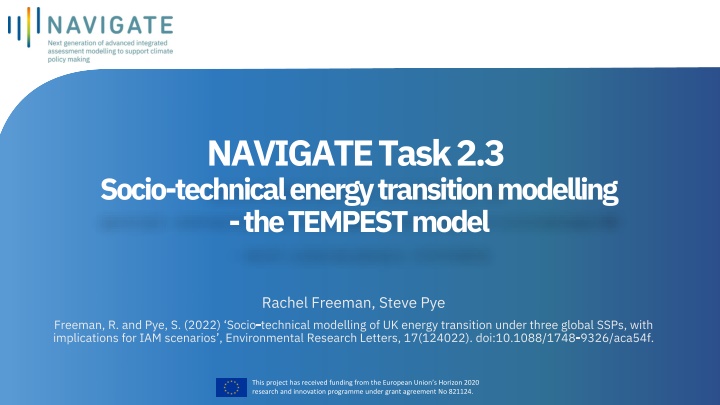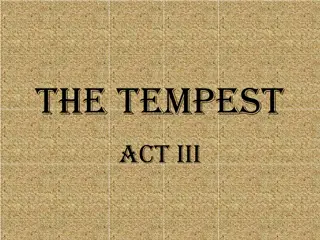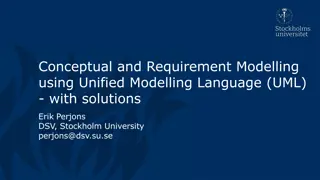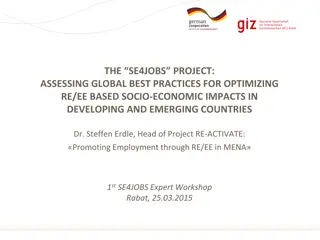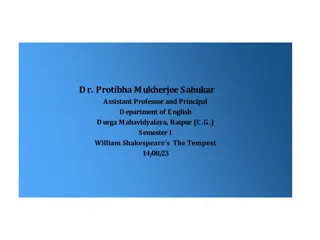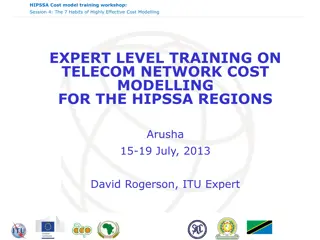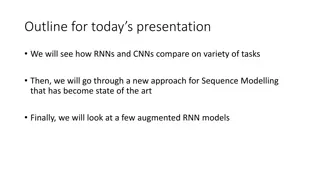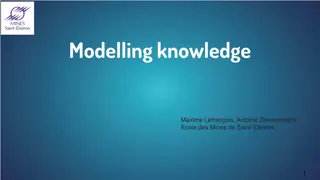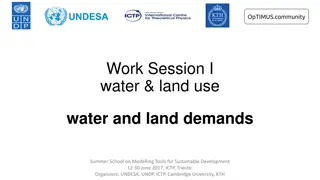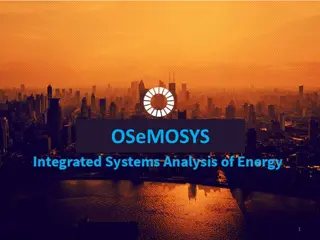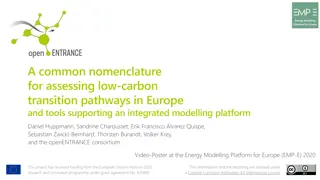Socio-technical Energy Transition Modelling: The TEMPEST Model
A simulation model, TEMPEST, incorporating societal and political factors, evaluates UK energy transition under three global SSPs. It analyzes the importance of political capital and societal preferences in adopting mitigation measures. The model's results are compared to the IMAGE model, suggesting higher energy demand reductions but lower emission reductions. Recommendations are provided to enhance the understanding of real-world feasibility of modelled pathways.
Download Presentation

Please find below an Image/Link to download the presentation.
The content on the website is provided AS IS for your information and personal use only. It may not be sold, licensed, or shared on other websites without obtaining consent from the author.If you encounter any issues during the download, it is possible that the publisher has removed the file from their server.
You are allowed to download the files provided on this website for personal or commercial use, subject to the condition that they are used lawfully. All files are the property of their respective owners.
The content on the website is provided AS IS for your information and personal use only. It may not be sold, licensed, or shared on other websites without obtaining consent from the author.
E N D
Presentation Transcript
NAVIGATE Task 2.3 Socio-technical energy transition modelling -the TEMPEST model Rachel Freeman, Steve Pye Freeman, R. and Pye, S. (2022) Socio-technical modelling of UK energy transition under three global SSPs, with implications for IAM scenarios , Environmental Research Letters, 17(124022). doi:10.1088/1748-9326/aca54f. This project has received funding from the European Union s Horizon 2020 research and innovation programme under grant agreement No 821124.
Overview A socio-technical energy transition simulation model, TEMPEST, incorporates societal and political factors influencing transition Societal preferences for different mitigation measures The importance of political capital as a fuel for energy transition SSP1, SSP2 and SSP5 are interpreted for TEMPEST and modelling results compared to those from IMAGE for the same SSPs Three recommendations for using TEMPEST results to improve understanding of the real-world feasibility of modelled IAM pathways This project has received funding from the European Union s Horizon 2020 research and innovation programme under grant agreement No 821124.
Model structure Target TEMPEST s simulation behaviours are endogenously generated from a system of interconnected feedback loops Political capital is used to create policy ambition Policy ambition increases the public willingness to participate in adopting mitigation measures + Distance_to target - 2.Balancing: measures in mix are more difficult as target is approached Scenario_input_(drivers_and barriers_for_political_capital) + - Pushback Political_capital for_energy transition 1.Balancing: mitigate while not at target - + + 4.Balancing: pushback can affect political capital 3.Balancing: policy ambition uses up political capital Scenario_inputs (population) + Policy ambition mix + - Mitigation achieved Scenario_inputs_(policy assignment_adjustments) - + - Public_willingness_to participate Measure difficulty 5.Reinforcing: measure achievements reduce difficulty scenario_inputs (disposable_income) - Learning_by doing + This project has received funding from the European Union s Horizon 2020 research and innovation programme under grant agreement No 821124.
Comparing trends from TEMPEST and IMAGE Rates of change in key indicators, in both models, are much lower in historic trends than in future indicating how challenging and disruptive future changes are likely to be IMAGE generally achieves higher emissions reductions (including BECCS that is not in TEMPEST) TEMPEST pathways have higher energy demand reductions; the power of demand-side changes might be underexplored in existing IAMs scenarios (Brutschin et al., 2021). This project has received funding from the European Union s Horizon 2020 research and innovation programme under grant agreement No 821124.
Recommendations Need Recommendation IAMs do not include uncertainty about the achievability of societal targets, and the importance of political and societal support (Keppo et al., 2021). Use TEMPEST results to set ranges of uncertainty in deployment of mitigation measures, which are driven by variability in political and societal factors. There is risk of climate mitigation targets not being met due to societal pushback (climate policy backlash (Patterson, 2023)) during times of rapid and disruptive change in energy systems. TEMPEST modelling shows a risk of up to 70% increase in emissions from strong pushback; TEMPEST findings could be used to assess IAM pathways for the magnitude of risk from pushback. Energy service demand (ESD) in IAMs is exogenously driven, with inputs derived from decomposition analysis. Yet ESD in future is expected to be influenced by social innovation in energy service provision and other wider societal changes due to energy transition. TEMPEST endogenously calculates ESD, allowing for testing of policy measures to influence ESD. TEMPEST results could be used to adjust IAM assumptions about avoid, shift improve behaviours to reflect a wider range of future societal responses and policy This project has received funding from the European Union s Horizon 2020 research and innovation programme under grant agreement No 821124. instruments.
